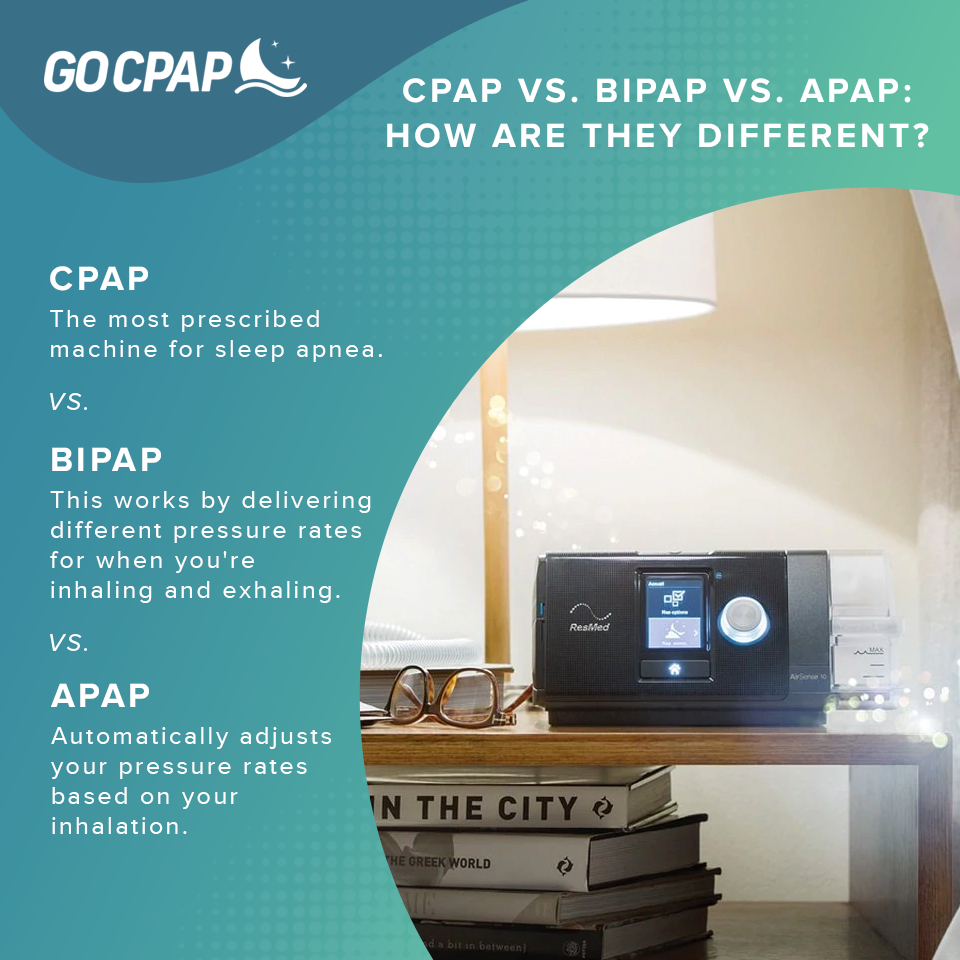Aug 27th 2020
CPAP vs. BiPAP vs. APAP: How are they different?
CPAP vs. BiPAP vs. APAP: How are they different?
When a healthy person sleeps, the muscles of the upper part of the throat allow air to flow into the lungs. However, when a person with OSA falls asleep, these muscles are not able to keep the air passage open all the time. When the airway closes, breathing stops, oxygen levels fall, and sleep is disrupted in order to open the airway.
The disruption of sleep usually lasts only a few seconds. However, these brief arousals interfere with sleep and prevent people with OSA from reaching the deep stages of sleep, such as rapid eye movement (REM) sleep, which the body needs in order to rest and replenish its strength. Once breathing is restored, people with OSA fall asleep only to repeat the cycle throughout the night.

How does CPAP therapy work?
Before everything else, let’s first discuss how CPAP works? With CPAP, the air is pushed from the flow generator through the tubing and mask. The air then passes through the nose and into the throat, where the slight pressure keeps the upper airway open.
Successful CPAP users report improvements in:
- Vitality and motivation
- Job performance
- Mood
- Sexual drive and performance
- Alertness while driving
- Quality of life
- Quality of sleep
A failure to use CPAP therapy may increase your risk for conditions linked to untreated OSA:
- Hypertension (OSA increases your risk of hypertension by up to five times)
- Stroke
- Congestive heart failure (CHF)
Why might I prefer an APAP machine?
Some CPAP users find it more pleasant to breath with APAP than with CPAP because the pressure automatically changes as needed to deliver the minimal pressure needed. With a CPAP the pressure is set at the highest necessary pressure to keep the airway open, even though the high pressure may only be needed a fraction of the time. APAP’s offer a great option for folks who are in a physician directed weight loss program or have changing pressure needs. Many APAP’s have been shown to maintain a lower average pressure since they only deliver what you need when you need it.
APAP is short for "Automatic Positive Airway Pressure." These machines are used in the treatment of obstructive sleep apnea (OSA). It automatically adjusts, on a breath-by-breath basis, to deliver the minimum pressure needed to keep the upper airway open during sleep. This allows the device provide you with your ideal pressure over the entire night. APAP machines tend to be more advanced and contain more features than CPAP devices.
Why might I prefer an BiPAP machine?
BiLevel devices can provide therapy for people with Obstructive Sleep Apnea (OSA) if they have found continuous positive airway pressure (CPAP) therapy too difficult. It can also provide noninvasive positive pressure ventilation (NPPV) for people with respiratory disorders or other forms of Sleep-Disordered Breathing (SDB).
BiLevel therapy works by delivering two different levels of positive air pressure:
- A higher level of pressure when you breathe in.
- A lower level of pressure when you breathe out.
Although both are non-invasive, BiLevel and CPAP therapy differ in two significant ways:
- BiLevel devices deliver two levels of air pressure that are set to coincide with the patient's inspiratory and expiratory efforts.
- BiLevel therapy can be used to treat conditions other than sleep apnea (OSA) and is the first line of treatment for a wide-range of respiratory disorders.
Do note that BiPAP therapy is not typically prescribed for OSA patients; however, OSA patients who require high treatment pressures or have another respiratory condition are often candidates for BiLevel therapy.
Physicians may also use BiLevel therapy to treat a broad range of conditions, including:
- Nocturnal hypoventilation
- Respiratory insufficiency
- Neuromuscular disease
- Respiratory failure
- Chest wall deformity
- Chronic obstructive pulmonary disease (COPD)
- ALS or Lou Gehrig's disease
Manufacturer Warranties
APAP, Bi-level, and CPAP machines all come with a warranty from the manufacturer. If you experience a malfunction with your equipment, please contact our office to determine if it is still covered by the warranty. You will also want to ask for the RMA number. Decisions regarding warranties are solely the manufacturer’s responsibility. You as the customer will be responsible for sending the equipment to our office, and the necessary replacements and repairs can take up to four weeks. We may be able to provide you with a rental machine during the time that you are without your equipment for repairs.











